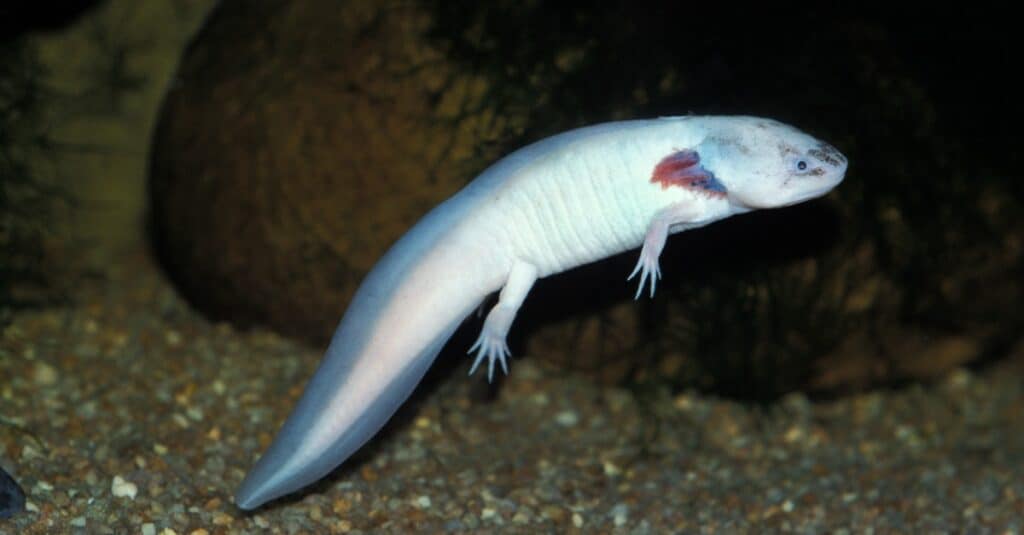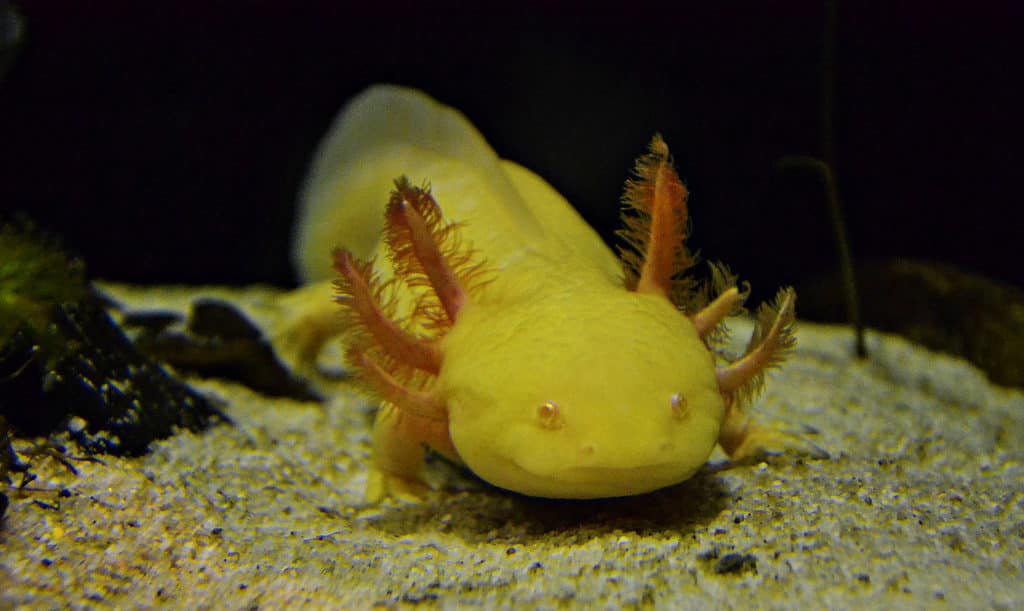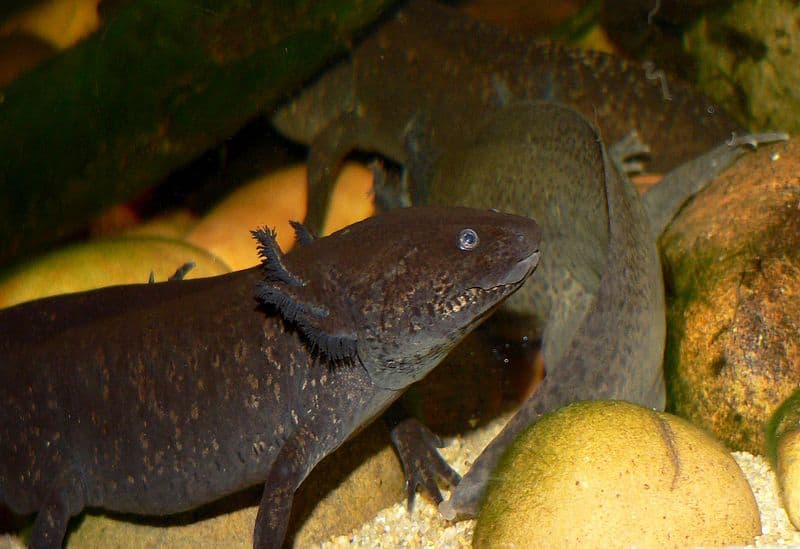Named after the mythical Aztec god of fire and lightning, the axolotl is a rare aquatic salamander that only exists naturally in the lake system of Mexico City. While related to the tiger salamander, the axolotl is among the most unique amphibians in the world. It will grow up and reach adulthood without ever undergoing the process of metamorphosis.
Known as neoteny, this means the adult still retains many juvenile features of the larvae, including the gill stalks and the ability to live in the water. It also has the amazing ability to regenerate limbs and other organs with ease, which has become the subject of intense scientific study. In the wild, this aquatic animal is characterized by light or dark brown skin with gold flecks around the body.
While critically endangered in the wild, the axolotl is raised by humans in captivity for both commercial and scientific purposes. Artificial selection (meaning human-driven evolution) has created many axolotl variations with different shapes, sizes, and colors compared with the wild type. It is now possible to find an aquatic axolotl that suits your particular visual and physical preferences.
This article will cover (in no particular order) some of the most interesting axolotl colors, including both common and rare variations. The rarer axolotl colors are obviously more difficult to find and generally more expensive than the common ones. Axolotls start at $40 or $50 and become quite pricy from there. Some of the rare axolotl colors can cost more than $1,000.
#10: White Albino Axolotl

©iStock.com/slowmotiongli
The white albino axolotl is among the most common artificial color morphs. Characterized by a pure white body, red gill filaments, and pink or white eyes, the albino morph is the result of the axolotl producing much less of the pigment known as melanin, which not only determines skin color but also protects the skin from UV radiation. The albino also lacks important pigments in the eye. As a result, this morph is considered to be very sensitive to bright light.
It would probably struggle to survive in the wild, but humans have seized on the albino skin color and bred more of them in captivity. The offspring needs to inherit two copies of the recessive albino gene in order to be an albino as well; just one copy won’t change the skin color at all. As they age, the albino undergoes a few different changes. The red color of the gill stalks tends to become even deeper, although the body stays completely white.
#9: Leucistic Axolotl

©Meggyn Pomerleau/Shutterstock.com
Although at first glance this is easy to mistake for the standard albino, the leucistic axolotl actually has more translucent see-through skin with red gill filaments and dark brown or black eyes. The main difference, biologically, is that the albino version is produced from a reduction of just the pigment melanin, whereas the leucistic version is produced from the reduction of all pigments in the skin. An alternative version called the speckled leucistic morph has the same translucent skin color but also some dark green, brown, or black speckles on the head, back, and tail.
The larvae start out as a regular leucistic morph, and then the speckles appear as the pigment cells mature. Both the leucistic and the speckled are considered to be fairly common morphs of axolotl color in the pet trade.
#8: Piebald Axolotl
The piebald morph is among a rare axolotl color. It is the result of a partial leucistic morph in which dark green or black spots or patches cover parts of the white/translucent skin. Most of the patches cover the face and back and rarely the sides and legs. It is different from the speckled leucistic morph due to the extreme amount of spots on the body. The piebald spots can darken with time until the skin becomes completely covered in black-and-white markings. The specific gene that causes this pattern can be inherited, but it’s very rare.
#7: Golden Albino Axolotl

©iStock.com/Trebor Eckscher
The golden albino is actually the most common artificial axolotl color. It is characterized by bright gold skin (as well as white, pink, or yellow eyes and reflective patches covering the body) that subtly changes color from white to yellow to orange-gold over the course of its lifetime. When it first hatches, the golden albino larvae are almost indistinguishable from an albino, but toward the end of its life, the golden color looks quite lustrous on them. This color morph is the result of almost all pigments being suppressed except for one that causes yellow and gold.
#6: Copper Axolotl

The copper axolotl is usually found in the United States and Australia.
©iStock.com/Lucia Martini
This fairly uncommon morph has a light gray-green body with copper-colored flecks spread fairly evenly across the surface of the skin. It also has gray-colored eyes and gray-red gills. The unusual combination is the result of lower levels of melanin and other pigments in the skin. The copper morph is most likely to be found in the United States and Australia; it is fairly rare in other countries. When crossed with other morphs, they can produce some very interesting axolotls color combinations.
#5: Black Melanoid Axolotl

The black melanoid is one of the most common axolotl morphs.
©Stan Shebs, CC BY-SA 3.0, via Wikimedia Commons – License
First discovered in 1961, the black melanoid is now among the most common axolotl color morphs in the world. The particular mixture of pigments in its skin produces a large range between dark green and completely black morphs with dark purple gills and a pale gray or purple belly as well. Some individuals look similar to the wild-type axolotl except for the lack of the golden iris. The black morph is basically the exact opposite of the albino color morph.
#4: Lavender Axolotl
This axolotl color morph is defined by a light silvery and purple hue, as well as gray-red gills and black eyes, that can become gray or green as it ages. The presence of spots all over the body has given it the alternative name of silver Dalmatian axolotl. These rare variations may be difficult to find and even more expensive than a normal color morph, but the color combination is truly unique.
#3: Firefly Axolotl
This is perhaps the most controversial axolotl color morph on the list. The firefly morph is a dark-colored wild-type axolotl with an albino tail that will actually glow in the dark under the glare of a black light, thanks to the presence of a green fluorescent protein. The gene that produces this glowing protein was originally transplanted into the axolotl from a jellyfish for the purpose of studying cancer resistance.
The original axolotls to undergo this procedure had glowing light-colored skin across the entire body. It was then introduced into a dark-colored wild-type axolotl when two embryos were fused together. The firefly is an entirely artificial creation, and the controversy is whether this method is suitable for creating pets.
#2: Chimera Axolotl
Chimera axolotl morphs are very rare variations produced by an accident in development. Characterized by half-white and half-black skin color split right down the horizontal length of the body, the chimera is the result of two eggs (one wild type and one albino) morphing together before hatching. They are so rare and so unusual that they are not consistently sold by stores. Many of the eggs do not hatch because they fail to fuse properly.
The name chimera comes from a creature found in Greek mythology which has a unique appearance due to the combination of multiple animal forms in one beast, such as a goat’s body, a lion‘s head, and a serpent’s tail. Because the chimera axolotl has horizontal color division rather than the random coloration found in other axolotls, it has the look of an imaginary animal or one that has been fabricated from different parts.
#1: Mosaic Axolotl
The mosaic axolotl morphs is another of the rare axolotl colors that you cannot generally find in stores, and even if you did happen to find one, they would probably be very expensive to buy. It is created from a combination of two eggs fusing together: one egg is an albino/leucistic and the other is dark or wild type. But instead of the colors being split down the middle like the chimera, the result is a randomly mottled salamander with black, white, and golden flecks. The mosaic may also have striped red or purple gills to enhance its peculiar appearance.
According to our research, 10 types of axolotl morphs are as follows:
Summary Of The 10 Types of Axolotl Morphs
| Rank | Axolotl Morph |
|---|---|
| 10 | White albino |
| 9 | Leucistic |
| 8 | Piebald |
| 7 | Golden albino |
| 6 | Copper |
| 5 | Black melanoid |
| 4 | Lavender |
| 3 | Firefly |
| 2 | Chimera |
| 1 | Mosaic |
The photo featured at the top of this post is © iStock.com/NORRIE3699
Thank you for reading! Have some feedback for us? Contact the AZ Animals editorial team.







